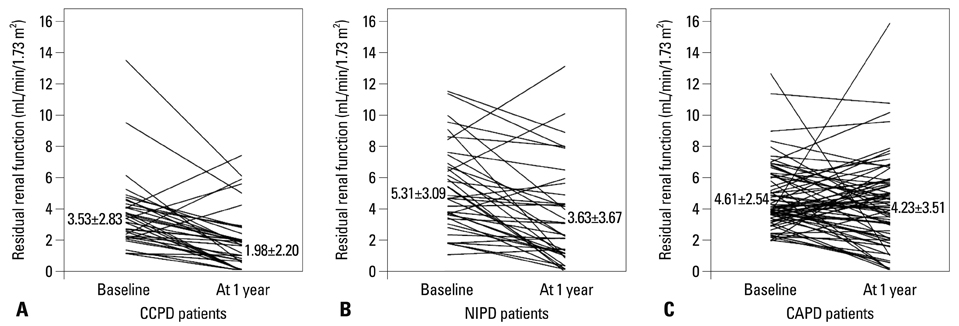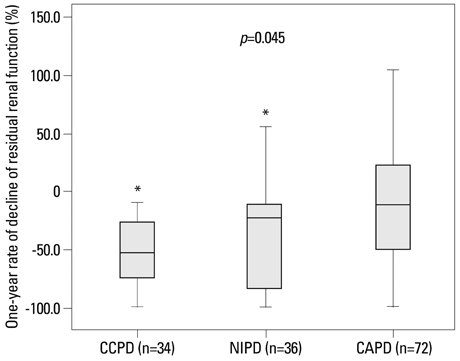Yonsei Med J.
2014 Jan;55(1):141-148. 10.3349/ymj.2014.55.1.141.
Effect of Peritoneal Dialysis Modality on the 1-Year Rate of Decline of Residual Renal Function
- Affiliations
-
- 1Department of Internal Medicine, Yonsei University College of Medicine, Seoul, Korea. khchoi6@yuhs.ac
- 2Severance Biomedical Science Institute, Brain Korea 21, Yonsei University, Seoul, Korea.
- KMID: 1779898
- DOI: http://doi.org/10.3349/ymj.2014.55.1.141
Abstract
- PURPOSE
The effect of different peritoneal dialysis (PD) modalities on the decline in residual renal function (RRF) is unclear due to inconsistencies among studies. In particular, the effect of automated peritoneal dialysis (APD) modalities [continuous cyclic peritoneal dialysis (CCPD) and nightly intermittent peritoneal dialysis (NIPD)] on RRF has not been examined in a large cohort.
MATERIALS AND METHODS
We conducted a single-center retrospective study to investigate the association between PD modalities and decline in RRF in 142 incident PD patients [34 on CCPD, 36 on NIPD, and 72 on continuous ambulatory peritoneal dialysis (CAPD)]. RRF was measured within 2 months from PD start and at 1 year after PD initiation.
RESULTS
The RRF at 1 year after PD initiation was 1.98+/-2.20 mL/min/1.73 m2 in CCPD patients and 3.63+/-3.67 mL/min/1.73 m2 in NIPD patients, which were moderately lower than 4.23+/-3.51 mL/min/1.73 m2 in CAPD patients (p=0.064). Moreover, there was no significant difference in the 1-year rate of decline of RRF between CCPD and NIPD patients, although APD patients had a faster 1-year RRF decline rate than CAPD patients (CCPD and NIPD vs. CAPD: -45.68 and -36.69 vs. 1.17%/year, p=0.045). APD was associated with a more rapid decline in RRF in patients with end-stage renal disease undergoing PD, although multivariate analysis attenuated the significance of this finding (beta=-31.50; 95% CI, -63.61 to 0.62; p=0.052).
CONCLUSION
Our results suggest that CAPD might be more helpful than APD for preserving RRF during the first year of dialysis therapy, although there was no significant difference in the 1-year rate of decline of RRF between the two APD modalities.
Keyword
MeSH Terms
Figure
Reference
-
1. Liao CT, Chen YM, Shiao CC, Hu FC, Huang JW, Kao TW, et al. Rate of decline of residual renal function is associated with all-cause mortality and technique failure in patients on long-term peritoneal dialysis. Nephrol Dial Transplant. 2009; 24:2909–2914.
Article2. Marrón B, Remón C, Pérez-Fontán M, Quirós P, Ortíz A. Benefits of preserving residual renal function in peritoneal dialysis. Kidney Int Suppl. 2008; S42–S51.
Article3. Canada-USA (CANUSA) Peritoneal Dialysis Study Group. Adequacy of dialysis and nutrition in continuous peritoneal dialysis: association with clinical outcomes. J Am Soc Nephrol. 1996; 7:198–207.4. Bargman JM, Golper TA. The importance of residual renal function for patients on dialysis. Nephrol Dial Transplant. 2005; 20:671–673.
Article5. Wang AY, Lai KN. The importance of residual renal function in dialysis patients. Kidney Int. 2006; 69:1726–1732.
Article6. Chandna SM, Farrington K. Residual renal function: considerations on its importance and preservation in dialysis patients. Semin Dial. 2004; 17:196–201.
Article7. Jansen MA, Hart AA, Korevaar JC, Dekker FW, Boeschoten EW, Krediet RT, et al. Predictors of the rate of decline of residual renal function in incident dialysis patients. Kidney Int. 2002; 62:1046–1053.
Article8. Lameire NH. The impact of residual renal function on the adequacy of peritoneal dialysis. Nephron. 1997; 77:13–28.
Article9. Moist LM, Port FK, Orzol SM, Young EW, Ostbye T, Wolfe RA, et al. Predictors of loss of residual renal function among new dialysis patients. J Am Soc Nephrol. 2000; 11:556–564.
Article10. Hiroshige K, Yuu K, Soejima M, Takasugi M, Kuroiwa A. Rapid decline of residual renal function in patients on automated peritoneal dialysis. Perit Dial Int. 1996; 16:307–315.
Article11. Hufnagel G, Michel C, Queffeulou G, Skhiri H, Damieri H, Mignon F. The influence of automated peritoneal dialysis on the decrease in residual renal function. Nephrol Dial Transplant. 1999; 14:1224–1228.
Article12. Michels WM, Verduijn M, Grootendorst DC, le Cessie S, Boeschoten EW, Dekker FW, et al. Decline in residual renal function in automated compared with continuous ambulatory peritoneal dialysis. Clin J Am Soc Nephrol. 2011; 6:537–542.
Article13. Rodriguez-Carmona A, Pérez-Fontán M, Garca-Naveiro R, Villaverde P, Peteiro J. Compared time profiles of ultrafiltration, sodium removal, and renal function in incident CAPD and automated peritoneal dialysis patients. Am J Kidney Dis. 2004; 44:132–145.
Article14. Bro S, Bjorner JB, Tofte-Jensen P, Klem S, Almtoft B, Danielsen H, et al. A prospective, randomized multicenter study comparing APD and CAPD treatment. Perit Dial Int. 1999; 19:526–533.
Article15. de Fijter CW, Oe LP, Nauta JJ, van der Meulen J, Verbrugh HA, Verhoef J, et al. Clinical efficacy and morbidity associated with continuous cyclic compared with continuous ambulatory peritoneal dialysis. Ann Intern Med. 1994; 120:264–271.
Article16. Hamada C, Osada S, Inoue S, Tanaka A, Fukui M, Kubota M, et al. Effects of automated peritoneal dialysis on residual urinary volume. Perit Dial Int. 2000; 20:239–241.
Article17. Johnson DW, Mudge DW, Sturtevant JM, Hawley CM, Campbell SB, Isbel NM, et al. Predictors of decline of residual renal function in new peritoneal dialysis patients. Perit Dial Int. 2003; 23:276–283.
Article18. Liao CT, Shiao CC, Huang JW, Hung KY, Chuang HF, Chen YM, et al. Predictors of faster decline of residual renal function in Taiwanese peritoneal dialysis patients. Perit Dial Int. 2008; 28:Suppl 3. S191–S195.
Article19. Singhal MK, Bhaskaran S, Vidgen E, Bargman JM, Vas SI, Oreopoulos DG. Rate of decline of residual renal function in patients on continuous peritoneal dialysis and factors affecting it. Perit Dial Int. 2000; 20:429–438.
Article20. Beddhu S, Bruns FJ, Saul M, Seddon P, Zeidel ML. A simple comorbidity scale predicts clinical outcomes and costs in dialysis patients. Am J Med. 2000; 108:609–613.
Article21. Twardowski ZJ. Clinical value of standardized equilibration tests in CAPD patients. Blood Purif. 1989; 7:95–108.
Article22. Perl J, Bargman JM. The importance of residual kidney function for patients on dialysis: a critical review. Am J Kidney Dis. 2009; 53:1068–1081.
Article23. Rottembourg J. Residual renal function and recovery of renal function in patients treated by CAPD. Kidney Int Suppl. 1993; 40:S106–S110.24. Agraharkar M, Nair V, Patlovany M. Recovery of renal function in dialysis patients. BMC Nephrol. 2003; 4:9.
Article25. Szeto CC, Chow KM. Residual renal function and recovery of renal function. Perit Dial Int. 2007; 27:159–161.
Article26. Davies SJ. Preserving residual renal function in peritoneal dialysis: volume or biocompatibility? Nephrol Dial Transplant. 2009; 24:2620–2622.
Article27. Davies SJ, Garcia Lopez E, Woodrow G, Donovan K, Plum J, Williams P, et al. Longitudinal relationships between fluid status, inflammation, urine volume and plasma metabolites of icodextrin in patients randomized to glucose or icodextrin for the long exchange. Nephrol Dial Transplant. 2008; 23:2982–2988.
Article28. Davies SJ, Woodrow G, Donovan K, Plum J, Williams P, Johans AC, et al. Icodextrin improves the fluid status of peritoneal dialysis patients: results of a double-blind randomized controlled trial. J Am Soc Nephrol. 2003; 14:2338–2344.
Article29. Konings CJ, Kooman JP, Gladziwa U, van der Sande FM, Leunissen KM. A decline in residual glomerular filtration during the use of icodextrin may be due to underhydration. Kidney Int. 2005; 67:1190–1191.
Article30. Konings CJ, Kooman JP, Schonck M, Gladziwa U, Wirtz J, van den Wall Bake AW, et al. Effect of icodextrin on volume status, blood pressure and echocardiographic parameters: a randomized study. Kidney Int. 2003; 63:1556–1563.
Article31. Brunkhorst R, Wrenger E, Krautzig S, Ehlerding G, Mahiout A, Koch KM. Clinical experience with home automated peritoneal dialysis. Kidney Int Suppl. 1994; 48:S25–S30.32. Holley JL, Bernardini J, Piraino B. Continuous cycling peritoneal dialysis is associated with lower rates of catheter infections than continuous ambulatory peritoneal dialysis. Am J Kidney Dis. 1990; 16:133–136.
Article33. Korbet SM, Vonesh EF, Firanek CA. Peritonitis in an urban peritoneal dialysis program: an analysis of infecting pathogens. Am J Kidney Dis. 1995; 26:47–53.
Article34. Rodríguez-Carmona A, Pérez Fontán M, García Falcón T, Fernández Rivera C, Valdés F. A comparative analysis on the incidence of peritonitis and exit-site infection in CAPD and automated peritoneal dialysis. Perit Dial Int. 1999; 19:253–258.
Article35. Adachi Y, Nakagawa Y, Nishio A. Icodextrin preserves residual renal function in patients treated with automated peritoneal dialysis. Perit Dial Int. 2006; 26:405–407.
Article36. Haag-Weber M, Krämer R, Haake R, Islam MS, Prischl F, Haug U, et al. Low-GDP fluid (Gambrosol trio) attenuates decline of residual renal function in PD patients: a prospective randomized study. Nephrol Dial Transplant. 2010; 25:2288–2296.
Article37. Kim S, Oh J, Kim S, Chung W, Ahn C, Kim SG, et al. Benefits of biocompatible PD fluid for preservation of residual renal function in incident CAPD patients: a 1-year study. Nephrol Dial Transplant. 2009; 24:2899–2908.
Article38. Rodríguez-Carmona A, Pérez Fontán M, García López E, García Falcón T, Díaz Cambre H. Use of icodextrin during nocturnal automated peritoneal dialysis allows sustained ultrafiltration while reducing the peritoneal glucose load: a randomized crossover study. Perit Dial Int. 2007; 27:260–266.
Article39. Williams JD, Topley N, Craig KJ, Mackenzie RK, Pischetsrieder M, Lage C, et al. The Euro-Balance Trial: the effect of a new biocompatible peritoneal dialysis fluid (balance) on the peritoneal membrane. Kidney Int. 2004; 66:408–418.
Article40. Fan SL, Pile T, Punzalan S, Raftery MJ, Yaqoob MM. Randomized controlled study of biocompatible peritoneal dialysis solutions: effect on residual renal function. Kidney Int. 2008; 73:200–206.
Article41. Szeto CC, Chow KM, Lam CW, Leung CB, Kwan BC, Chung KY, et al. Clinical biocompatibility of a neutral peritoneal dialysis solution with minimal glucose-degradation products--a 1-year randomized control trial. Nephrol Dial Transplant. 2007; 22:552–559.
Article42. Balasubramanian G, McKitty K, Fan SL. Comparing automated peritoneal dialysis with continuous ambulatory peritoneal dialysis: survival and quality of life differences? Nephrol Dial Transplant. 2011; 26:1702–1708.
Article
- Full Text Links
- Actions
-
Cited
- CITED
-
- Close
- Share
- Similar articles
-
- Peritoneal Dialysis
- The Effect of Growth Hormone and the Factors Influencing Growth in Pediatric Chronic Peritoneal Dialysis Patients
- The Effect of Residual Renal Function at the Initiation of Dialysis on Patient Survival
- Risk Factors Influencing Decline of Residual Renal Function in Patients on Continuous Ambulatory Peritoneal Dialysis
- Peritoneal dialysis in children and adolescents




